Intercomparison on Four Irrigated Cropland Maps in Mainland China
Abstract
1. Introduction
2. Materials and Methods
2.1. Four Irrigated Cropland Datasets
2.2. Comparion Method
3. Results
3.1. Visual Observation of Four Maps
3.2. Quantitative Comparison
3.2.1. Ratios of Irrigated Croplands
3.2.2. Influence of MCPs
3.3. Spatial Comparison
3.3.1. Spatial Agreement
3.3.2. Influence of MCPs
4. Discussion
5. Conclusions
Acknowledgments
Author Contributions
Conflicts of Interest
References
- Doll, P.; Siebert, S. A digital global map of irrigated areas. Int. Comm. Irrig. Drain. J. 2000, 49, 55–66. [Google Scholar] [CrossRef]
- Siebert, S.; Henrich, V.; Frenken, K.; Burke, J. Update of the Digital Global Map of Irrigation Areas (GMIA) to Version 5; Institute of Crop Science and Resource Conservation, University of Bonn: Bonn, Germany; Food and Agriculture Organization of the United Nations: Rome, Italy, 2013. [Google Scholar] [CrossRef]
- Portmann, F.T.; Siebert, S.; Doll, P. MIRCA2000–global monthly irrigated and rainfed crop areas around the year 2000: A new high-resolution data set for agricultural and hydrological modeling. Glob. Biogeochem. Cycles 2010, 24, 2013–2024. [Google Scholar] [CrossRef]
- Thenkabail, P.S.; Biradar, C.M.; Noojipady, P.; Dheeravath, V.; Li, Y.J.; Velpuri, M.; Gumma, M.; Gangalakunta, O.R.P.; Turral, H.; Cai, X.L.; et al. Global irrigated area map (GIAM), derived from remote sensing, for the end of the last millennium. Int. J. Remote Sens. 2009, 30, 3679–3733. [Google Scholar] [CrossRef]
- Biradar, C.M.; Thenkabail, P.S.; Noojipady, P.; Li, Y.J.; Dheeravath, V.; Turral, H.; Velpuri, M.; Gumma, M.K.; Gangalakunta, O.R.P.; Cai, X.L.; et al. A global map of rainfed cropland areas (GMRCA) at the end of last millennium using remote sensing. Int. J. Appl. Earth Obs. Geoinf. 2009, 11, 114–129. [Google Scholar] [CrossRef]
- Salmon, J.M.; Frield, M.A.; Frolking, S.; Wisser, D.; Douglas, E.M. Global rain-fed, irrigated, and paddy croplands: A new high resolution map derived from remote sensing, crop inventories and climate data. Int. J. Appl. Earth Obs. Geoinf. 2015, 38, 321–334. [Google Scholar] [CrossRef]
- Thenkabail, P.S.; Teluguntla, P.; Xiong, J.; Oliphant, A.; Massey, R. NASA MEaSUREs Global Food Security-Support Analysis Data (GFSAD) Crop Mask 2010 Global 1 km V001; NASA EOSDIS Land Processes Distributed Active Archive Center: Sioux Falls, SD, United State, 2016. [Google Scholar]
- Arino, O.; Bicheron, P.; Achard, F.; Latham, J.; Witt, R.; Weber, J.L. The most detailed portrait of Earth, ESA Bulletin; European Space Agency: Leuven, Netherlands, 2008. [Google Scholar]
- Bontemps, S.; Van Bogaert, E.; Defourny, P.; Kalogirou, V.; Arino, O. GlobCover2009 Products Description Manual, Version 1.0. Available online: http://ionial.esrin.esa.int/ (accessed on 27 May 2017).
- Zhu, X.F.; Zhu, W.Q.; Zhang, J.S.; Pan, Y.Z. Mapping irrigated areas in China from remote sensing and statistical data. IEEE J. Sel. Top. Appl. Earth Obs. Remote Sens. 2014, 7, 4490–4504. [Google Scholar] [CrossRef]
- Dong, T.T. Research on Classification between Irrigated Land and Fry Land and Landscape Pattern of China Based on Remote Sensing. Ph.D. Thesis, Chinese Academy of Science, Beijing, China, 2009. [Google Scholar]
- Muramatsu, K.; Ono, K.; Soyama, N.; Thanyapraneedkul, J.; Myata, A.; Mano, M. Determination of rice paddy parameters in the global gross primary production capacity estimation algorithm using 6 years of JP-MSE flux observation data. J. Agric. Meteorol. 2017, 73, 119–132. [Google Scholar] [CrossRef]
- Low, F.; Biradar, C.; Fliemann, E.; Lamers, J.P.A.; Conrad, C. Assessing gaps in irrigated agricultural productivity through satellite earth observations-A case study of the Fergana Valley, Central Asia. Int. J. Appl. Earth Obs. Geoinf. 2017, 59, 118–134. [Google Scholar] [CrossRef]
- Lawston, P.M.; Santanello, J.A.; Franz, T.E.; Rodell, M. Assessment of irrigation physics in a land surface modeling framework using non-traditional and human-practice datasets. Hydrol. Earth Syst. Sci. 2017, 21, 2953–2966. [Google Scholar] [CrossRef]
- Iizumi, T.; Furuya, J.; Shen, Z.H.; Kim, W.; Okada, M.; Fujimori, S.; Hasegawa, T.; Nishimori, M. Responses of crop yield growth to global temperature and socioeconomic changes. Sci. Rep. 2017, 7. [Google Scholar] [CrossRef] [PubMed]
- Dietrich, J.P.; Schmitz, C.; Muller, C.; Fader, M.; Lotze-Campen, H.; Popp, A. Measuring agricultural land-use intensity—A global analysis using a model-assisted approach. Ecol. Model. 2012, 232, 109–118. [Google Scholar] [CrossRef]
- Xiao, X.M.; Liu, J.Y.; Zhuang, D.F.; Frolking, S.; Boles, S.; Xu, B.; Liu, M.L.; Salas, W.; Moore, B.; Li, C.S. Uncertainties in estimates of cropland area in China: A comparison between an AVHRR-derived dataset and a Landsat TM-derived dataset. Glob. Planet. Chang. 2003, 37, 297–306. [Google Scholar] [CrossRef]
- Ran, Y.H.; Li, X.; Lu, L. Accuracy evaluation of the four remote sensing based land cover products over China. J. Glaciol. Geocryol. 2009, 3, 490–500. [Google Scholar]
- Fritz, S.; See, L.; Remold, F. Comparison of global and regional land cover maps with statistical information for the agricultural domain in Africa. Int. J. Remote Sens. 2010, 31, 2237–2256. [Google Scholar] [CrossRef]
- Tsendbazar, N.E.; de Bruin, S.; Herold, M. Assessing global land cover reference datasets for different user communities. ISPRS J. Photogramm. Remote Sens. 2015, 103, 93–114. [Google Scholar] [CrossRef]
- Yang, Y.K.; Xiao, P.F.; Feng, X.Z.; Li, H.X. Accuracy assessment of seven global land cover datasets over China. ISPRS J. Photogramm. Remote Sens. 2017, 125, 156–173. [Google Scholar] [CrossRef]
- Gao, Z.Y.; Mu, J.X. Development and function of irrigation in China. proceedings of the World Water Forum, Tokyo, Osaka, Shiga, Japan, 16–23 March 2003. [Google Scholar]
- Biggs, T.W.; Thenkabail, P.S.; Gumma, M.K.; Scott, C.A.; Parthasaradhi, G.R.; Turral, H.N. Irrigated area mapping in heterogeneous landscapes with MODIS time series, ground truth and census data, Krishna Basin, India. Int. J. Remote Sens. 2006, 27, 4245–4266. [Google Scholar] [CrossRef]
- Thenkabail, P.S.; GangadharaRao, P.; Biggs, T.W.; Krishna, M.; Turral, H. Spectral matching techniques to determine historical land-use/land-cover (LULC) and irrigated areas using time-series 0.1-degree AVHRR pathfinder datasets. Photogramm. Eng. Remote Sens. 2007, 73, 1029–1040. [Google Scholar]
- Thenkabail, P.S.; Hanjra, M.A.; Dheeravath, V.; Gumma, M. A Holistic View of Global Croplands and Their Water Use for Ensuring Global Food Security in the 21st Century through Advanced Remote Sensing and Non-remote Sensing Approaches. Remote Sens. 2010, 2, 211–261. [Google Scholar] [CrossRef]
- Wu, W.B.; Ryosuke, S.; Yang, P.; Zhou, Q.B.; Tang, H.J. Remote sensed estimation of cropland in China: A comparison of the maps derived from four global land cover datasets. Can. J. Remote Sens. 2008, 34, 467–479. [Google Scholar] [CrossRef]
- Xiao, X.; Boles, S.; Frolking, S.; Salas, W.; Moore, B.; Li, C.; He, L.; Zhao, R. Landscape-scale characterization of cropland in China using Vegetation and Landsat TM images. Int. J. Remote Sens. 2002, 23, 3579–3594. [Google Scholar] [CrossRef]
- Velpuri, N.M.; Thenkabial, P.S.; Gumma, M.K.; Biradar, C.; Dheeravath, V.; Noojipady, P.; Li, Y.J. Influence of resolution in irrigated area mapping and area estimation. Photogramm. Eng. Remote Sens. 2009, 75, 1383–1395. [Google Scholar] [CrossRef]
- Lu, M.; Wu, W.B.; Zhang, L.; Liao, A.P.; Peng, S.; Tang, H.J. A comparative analysis of five global cropland datasets in China. Sci. China Earth Sci. 2016, 59, 2307–2317. [Google Scholar] [CrossRef]
- Toomanian, N.; Gieske, A.S.M.; Akbary, M. Irrigated area determination by NOAA-Landsat upscaling techniques, Zayandeh River Basin, Esfahan, Iran. Int. J. Remote Sens. 2004, 25, 1–16. [Google Scholar] [CrossRef]
- Boken, V.K.; Hoogenboom, G.; Kogan, F.N.; Hooks, J.E.; Thomas, D.L.; Harrison, K.A. Potential of using NOAA-AVHRR data for estimating irrigated area to help solve an inter-state water dispute. Int. J. Remote Sens. 2004, 25, 2277–2286. [Google Scholar] [CrossRef]
- Wilkinson, G.G. Results and implications of a study of fifteen years of satellite image classification experiments. IEEE Trans. Geosci. Remote Sens. 2005, 43, 433–440. [Google Scholar] [CrossRef]
- Jia, K.; Li, Q.Z. Review of features selection in crop classification using remote sensing data. Resour. Sci. 2013, 12, 2507–2516. [Google Scholar]
- Abuzar, M.; McAllister, A.; Whitfield, D. Mapping irrigated farmlands using vegetation and thermal thresholds derived from Landsat and ASTER data in an irrigation district of Australia. Photogramm. Eng. Remote Sens. 2015, 81, 229–238. [Google Scholar] [CrossRef]
- Dheeravath, V.; Thenkabail, P.S.; Chandrakantha, G.; Noojipady, P.; Reddy, G.P.O.; Biradar, C.M.; Gumma, M.K.; Velpuri, M. Irrigated areas of India derived using MODIS 500m time series for the year 2001-2003. ISPRS J. Photogramm. Remote Sens. 2010, 65, 42–59. [Google Scholar] [CrossRef]
- Pairman, D.; Belliss, S.E.; Cuff, J.; McNeill, S.J. Detection and Mapping of Irrigated Farmland in Canterbury, New Zealand. In Proceedings of the IEEE International Geoscience and Remote Sensing Symposium, Vancouver, BC, Canada, 24-29 July 2011. [Google Scholar]
- Liu, Y.Z.; Wu, W.B.; Li, Z.L.; Zhou, Q.B. Recent progress in mapping irrigated cropland by remote sensing. Chin. J. Agric. Resour. Reg. Plan. 2017, 38, 1–13. [Google Scholar] [CrossRef]
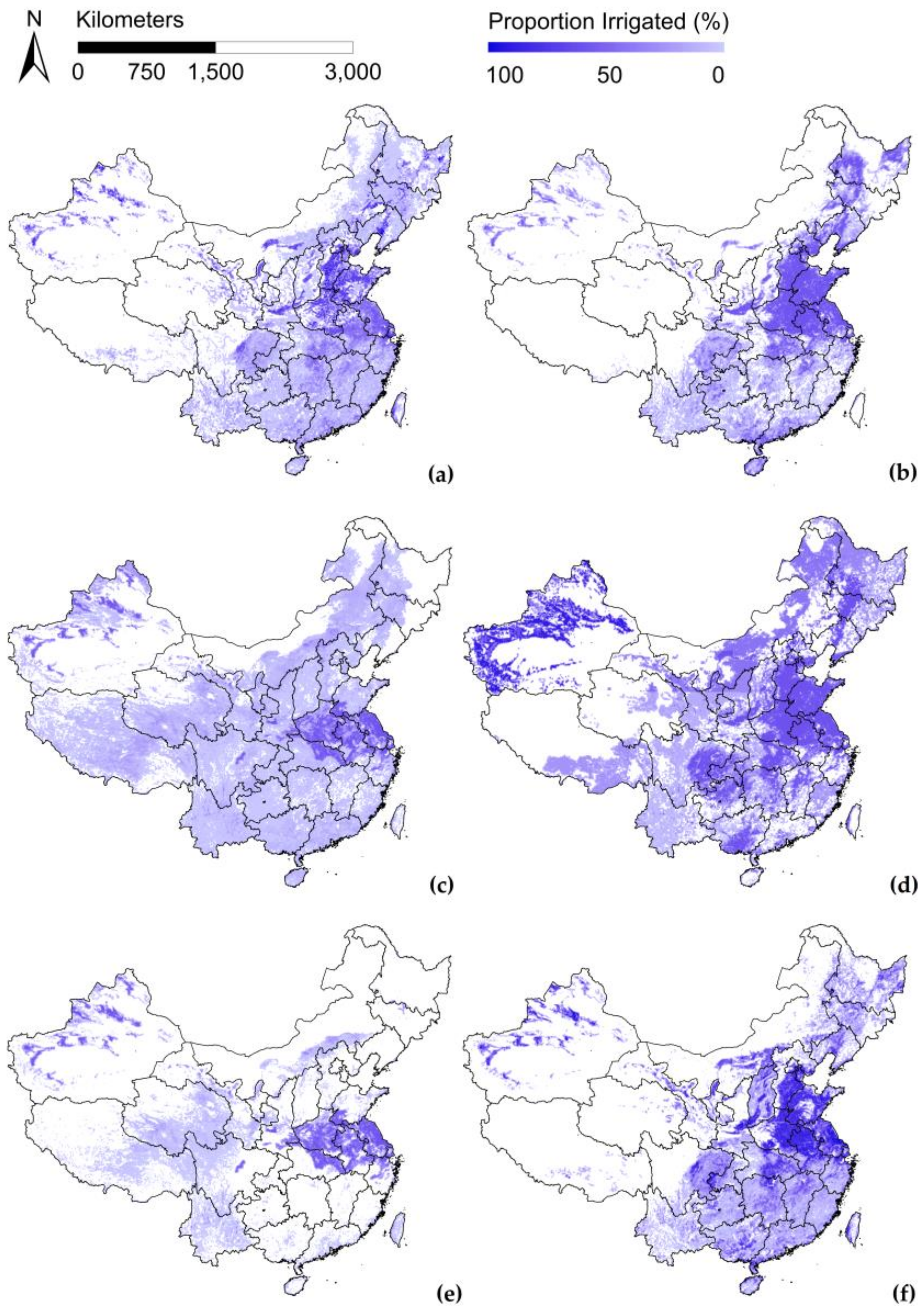
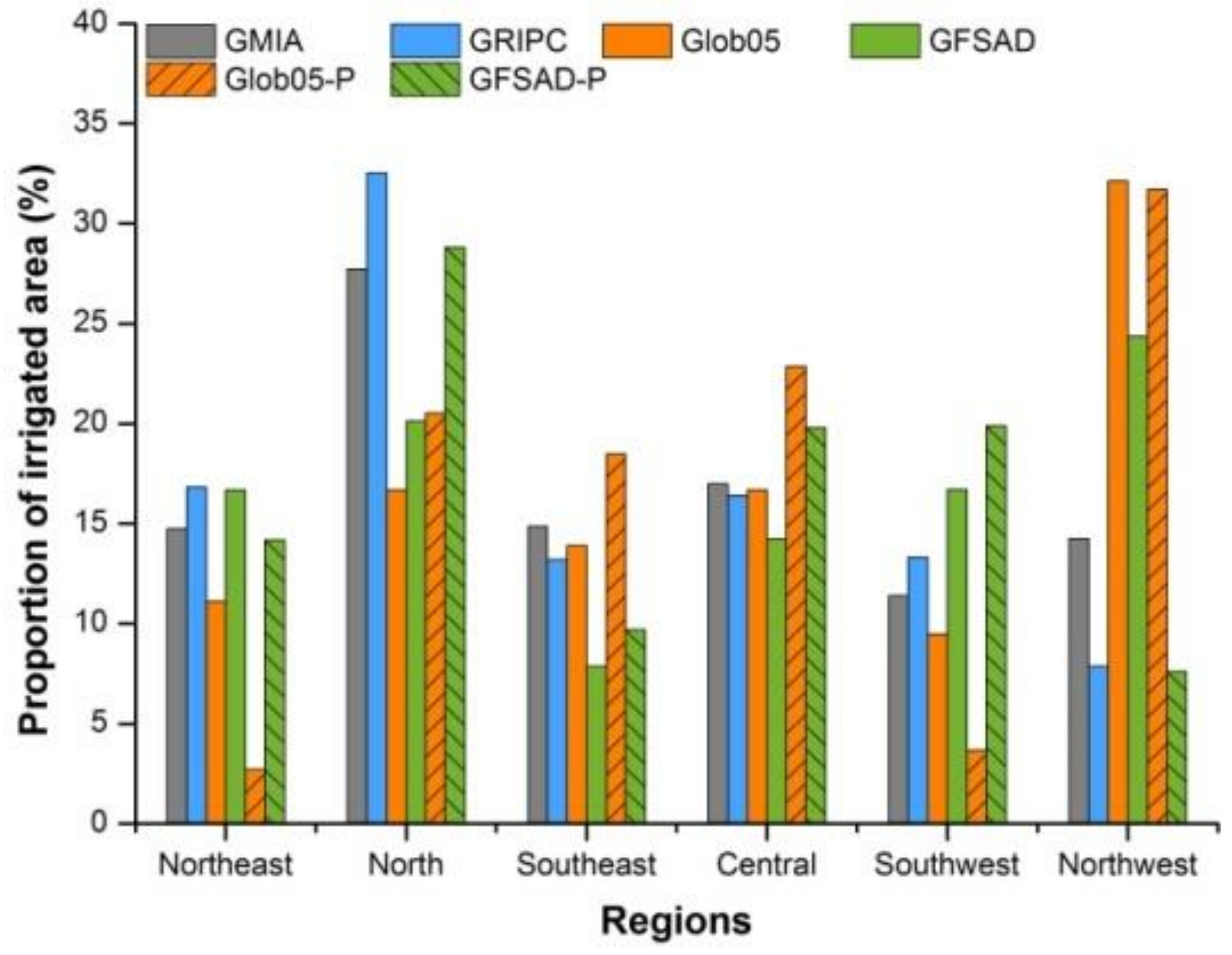
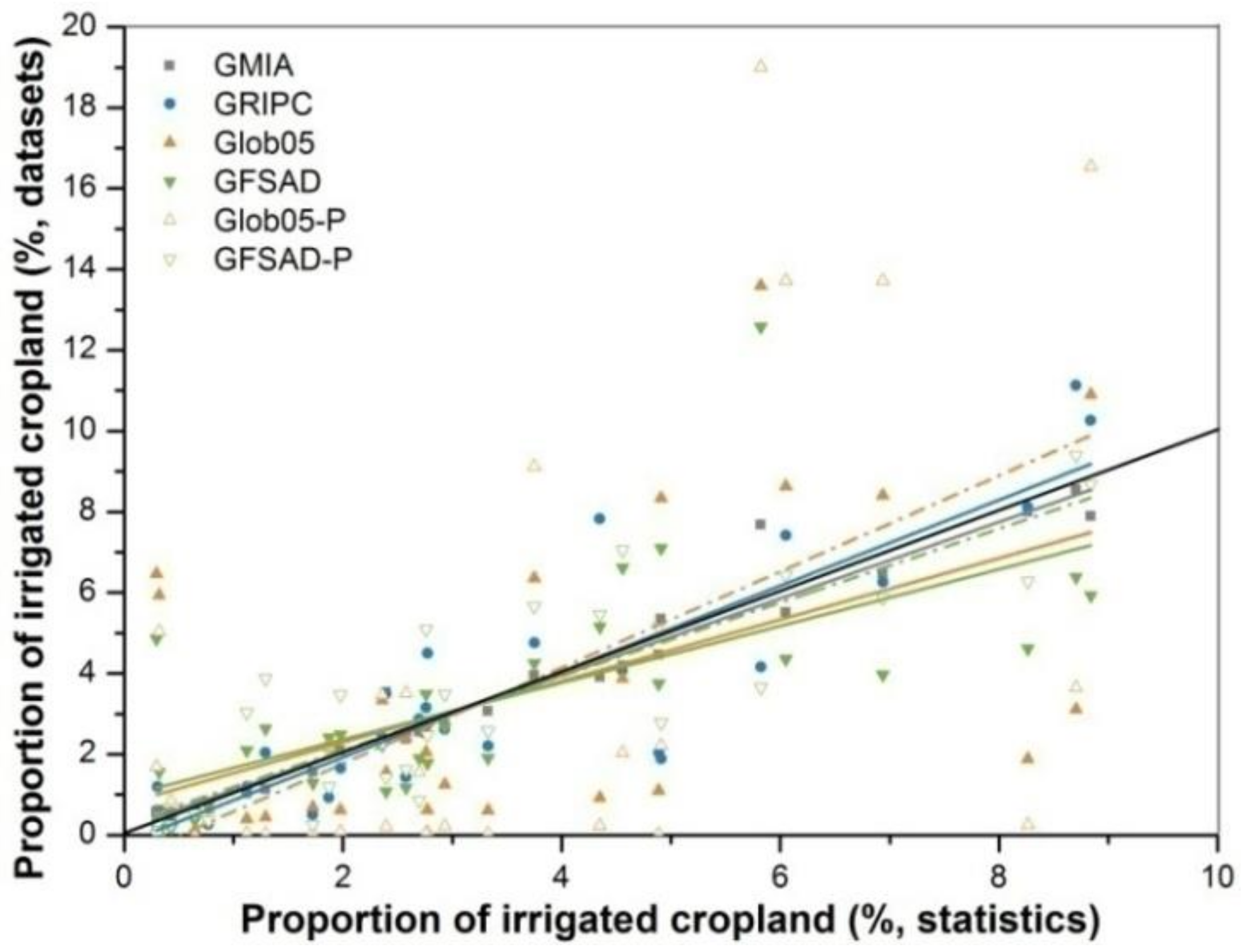
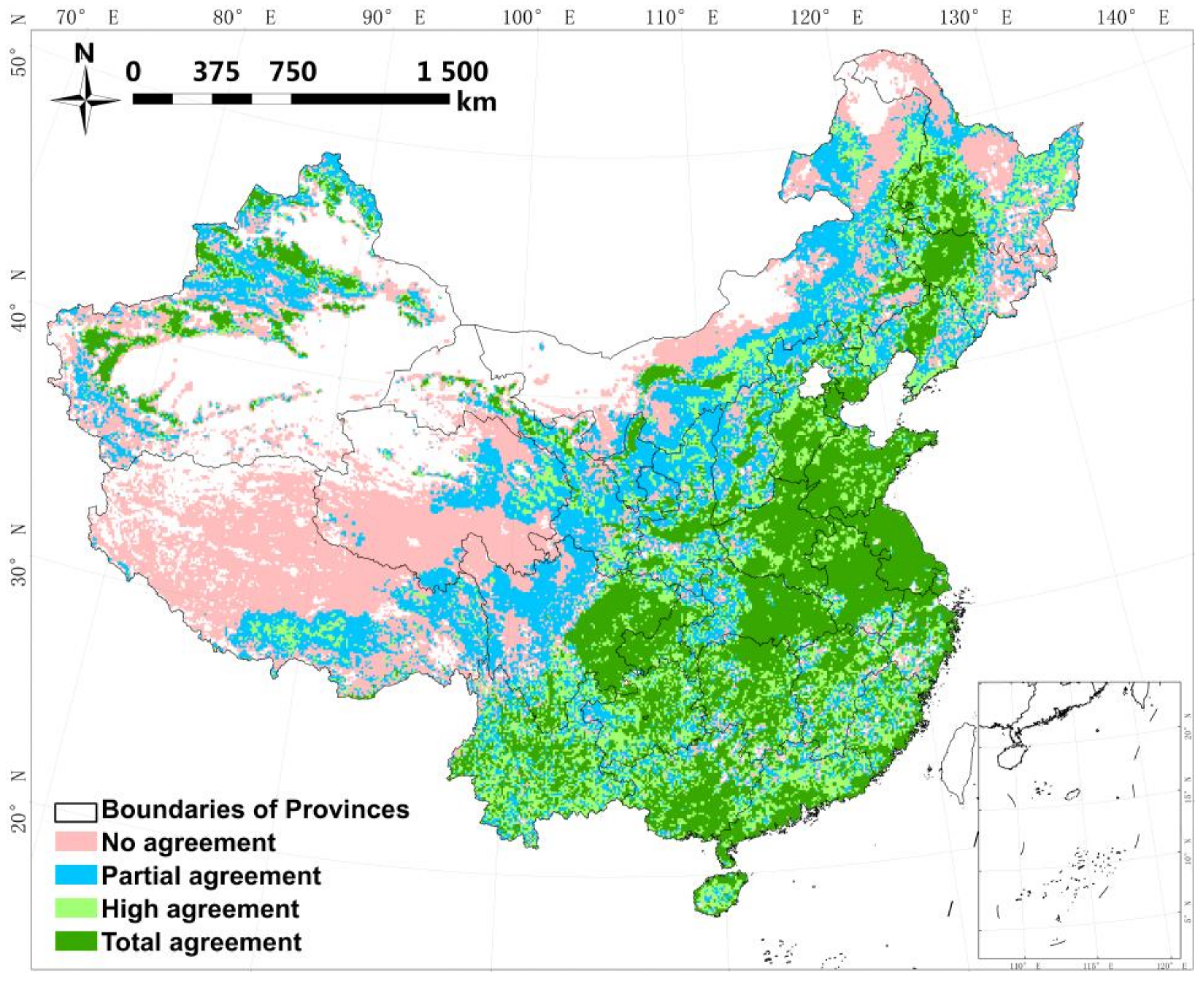
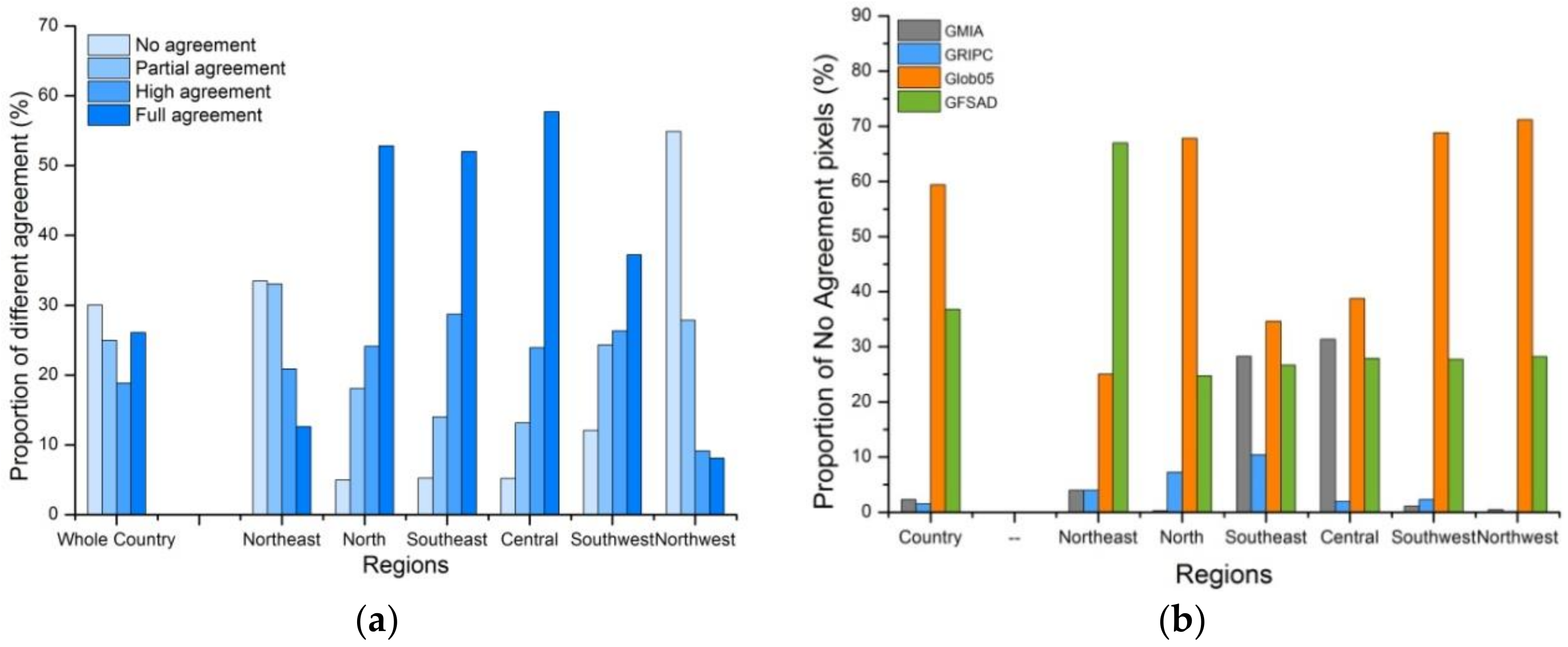
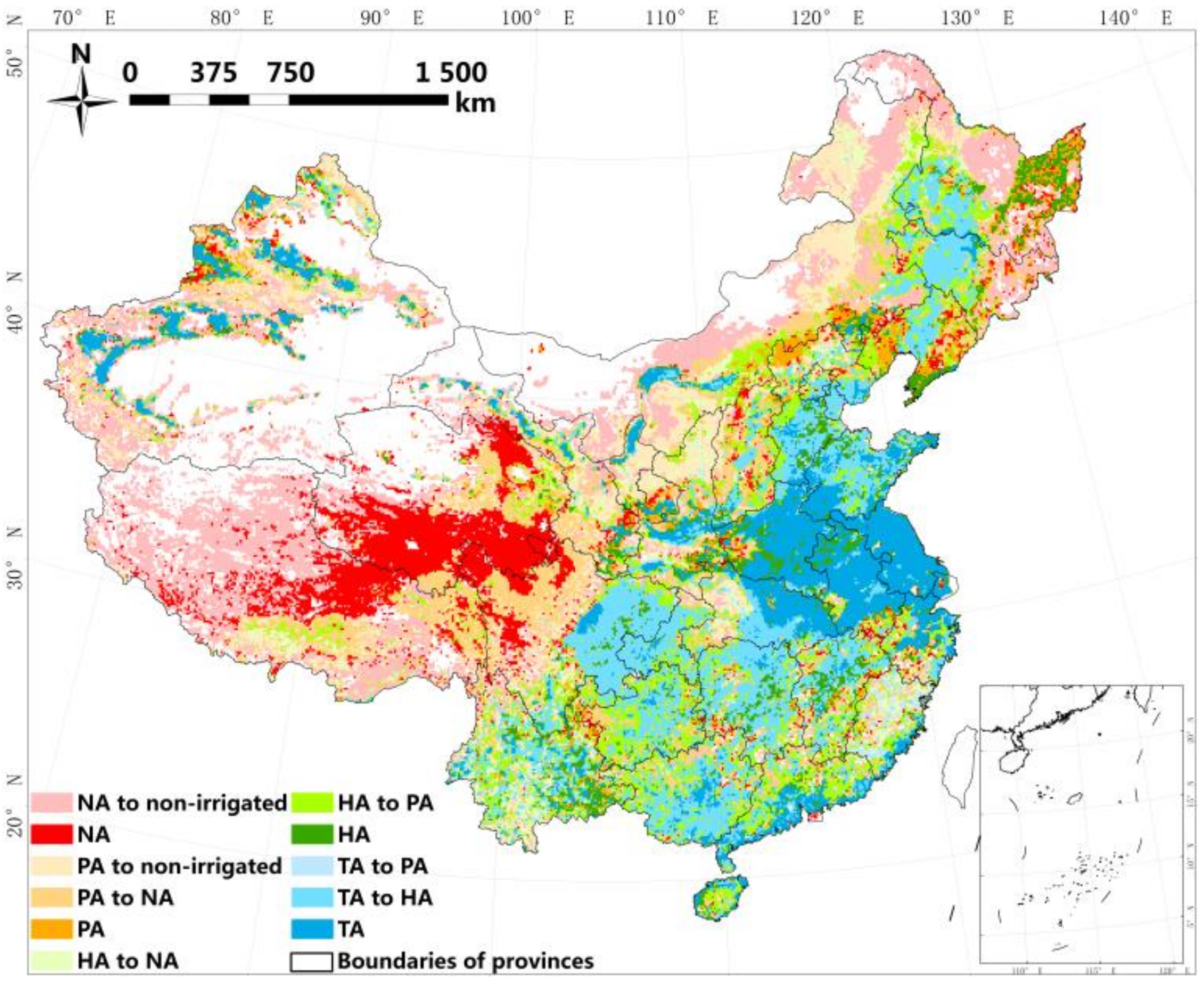
| Dataset. | Benchmark | Resolution | Subclasses | Conversion Ratio |
|---|---|---|---|---|
| GMIA | 2005 | 5 arcminute | 1. Area of effective irrigation (AEI) | 1 |
| 2. Area of actual irrigation (AAI) | ||||
| GRIPC | 2005 | 500 m | 1. Rainfed croplands without irrigation or paddy | |
| 2. Croplands irrigated but without paddy | 0.65 | |||
| 3. Paddy with waterflooding for at least 2 weeks | 0.65 | |||
| Glob05 | 2005 | 300 m | 1. Post-flooding or irrigated croplands | 0.71 |
| 2. Rainfed croplands | ||||
| 3. Cropland (50%–70%) with vegetation | 0.6 × EP | |||
| GFSAD | 2005 | 1 km | 1. Cropland irrigated by any water resource | 0.6 |
| 2. Totally rainfed croplands | ||||
| 3. Mosaic croplands (40%–60%) | 0.5 × EP |
| GMIA | GRIPC | Glob05 | GFSAD | Glob05-P | GFSAD-P | |
|---|---|---|---|---|---|---|
| RMSE | 0.50 | 1.37 | 3.05 | 1.97 | 4.47 | 1.34 |
| R | 0.96 | 0.80 | 0.29 | 0.46 | 0.32 | 0.75 |
| Slope | 0.95 | 1.06 | 0.76 | 0.70 | 1.18 | 0.91 |
| Intercept | 0.16 | -0.19 | 0.78 | 0.96 | -0.6 | 0.28 |
| Datasets/Regions | Northeast | North | Southeast | Central | Southwest | Northwest | Total |
|---|---|---|---|---|---|---|---|
| Glob05 | 14.38 | 72.20 | 78.08 | 80.53 | 22.81 | 57.96 | 58.72 |
| GFSAD | 57.39 | 96.59 | 83.17 | 93.82 | 80.33 | 21.11 | 67.49 |
© 2018 by the authors. Licensee MDPI, Basel, Switzerland. This article is an open access article distributed under the terms and conditions of the Creative Commons Attribution (CC BY) license (http://creativecommons.org/licenses/by/4.0/).
Share and Cite
Liu, Y.; Wu, W.; Li, H.; Imtiaz, M.; Li, Z.; Zhou, Q. Intercomparison on Four Irrigated Cropland Maps in Mainland China. Sensors 2018, 18, 1197. https://doi.org/10.3390/s18041197
Liu Y, Wu W, Li H, Imtiaz M, Li Z, Zhou Q. Intercomparison on Four Irrigated Cropland Maps in Mainland China. Sensors. 2018; 18(4):1197. https://doi.org/10.3390/s18041197
Chicago/Turabian StyleLiu, Yizhu, Wenbin Wu, Hailan Li, Muhammad Imtiaz, Zhaoliang Li, and Qingbo Zhou. 2018. "Intercomparison on Four Irrigated Cropland Maps in Mainland China" Sensors 18, no. 4: 1197. https://doi.org/10.3390/s18041197
APA StyleLiu, Y., Wu, W., Li, H., Imtiaz, M., Li, Z., & Zhou, Q. (2018). Intercomparison on Four Irrigated Cropland Maps in Mainland China. Sensors, 18(4), 1197. https://doi.org/10.3390/s18041197




